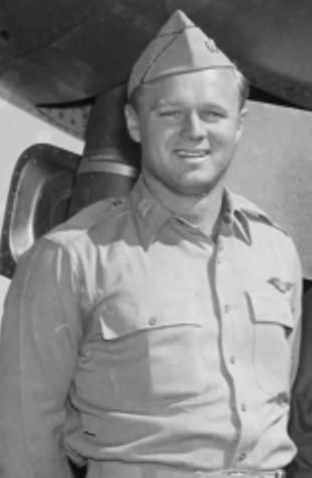William Floyd Hartshorn, Jr. was a lead pilot of the 216th flight test section at Wendover, Utah.
Early Life
Hartshorn was born on July 28, 1918 in McAllen, Texas. He grew up there and graduated from McAllen High School in 1935.
After attending Sam Houston State Teachers College in Huntsville, Texas, Hartshorn enrolled in the civilian pilot training program at Texas A & I (later A & M) College in Kingsville, Texas. There, he gained his advanced rating and continued on to San Antonio where he took flying tests from a Canadian air force instructor. On September 24, 1941, he received notice of his acceptance into the Royal Canadian Air Force (RCAF) and was enlisted into the RCAF in Montreal, Canada.
After spending about a year with the RCAF as an instructor, Hartshorn transferred into the U. S. Army Air Forces (AAF). Upon returning to the United States, he married his home town sweetheart, Joyce Priestley.
Hartshorn continued working as an instructor with the AAF. In 1944, he was a B-17 flight instructor at Lockbourne Army Airfield in Columbus, Ohio.
Manhattan Project
In February of 1945, Hartshorn was selected for a top secret assignment with the Manhattan Project. On February 27, 1945, he passed his final interview to become a B-29 pilot with the 216th Army Air Forces Base Unit Flight Test Section (FTS) at Wendover Field, Utah. The 216th helped run tests for dropping the atomic bombs. After assembling test bombs, they were installed in one of the 216th FTS’s Silverplate B-29s, specially modified to carry atomic bombs. These test bombs, all without fissile material, were drop tested at local Wendover targets or in southern California, where test drops were made at Sandy Beach at the Salton Sea test range. While stationed at Wendover, Hartshorn was promoted to Captain.
Hartshorn was also present at the Trinity test. During the Trinity test at Alamogordo, New Mexico, he was one of two pilots of the 216th assigned to overfly the detonation. The purpose of this mission was to drop blast measurement canisters by parachute above the detonation, as was planned for the combat missions over Japan. Despite severe thunderstorms on the morning of the test, Hartshorn took to the air and completed the mission. All in all, he can be credited with completing 64 out of 155 test drop missions originating from Wendover Field.
Hartshorn and his crew were also selected for some special delivery missions. On July 27, 1945 Hartshorn, his crew, and the last two 509th Composite Group crews remaining at Wendover flew to Kirtland Field, New Mexico in order to pick up three “Fat Man” bomb pre-assemblies complete with ballistic shells and tails, but lacking fissile material. On August 11, 1945, they were selected again to fly to Kirtland Field and load another complete “Fat Man” bomb pre-assembly for Tinian. Afterwards, Hartshorn proceeded to the Mather Field, California point of debarkation where he met up with Col. Clifford J. Heflin, the Commanding Officer of Wendover Field and the 216th unit. Here, Heflin took command and flew with Hartshorn and the rest of the crew to Tinian. However, with the pending Japanese surrender, all atomic bomb component shipments were halted and returned to Wendover Field.
In November of 1945, Hartshorn was discharged from the AAF and added to the active reserve. However, he was called back to active duty on February 8, 1946 to participate in Operation Crossroads, the first postwar atomic weapons tests taking place at the Bikini Atoll in the Marshall Islands.
Later Years
After leaving the service, Hartshorn lived in Albuquerque, New Mexico and worked for Cargo Air Service as a chief pilot. The company had a contract to fly cargo and scientists to different nuclear sites. In July of 1965, he relocated to Charleston, South Carolina to work as a pilot for Zan Top Air Transport Co.
Hartshorn died unexpectedly on September 4, 1965 of natural causes at the age of 47.





